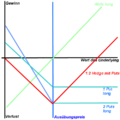Reverse hedge
Reverse hedge is an option strategy that combines securities and options . In contrast to the hedge , in which assets are to be protected in value with the help of options, in the "reverse" hedge assets are sold the other way around, the operator of the hedge transaction goes short ( short sale of the underlying) compared to the underlying (for example a share ), and to either simultaneously purchase options long (acquisition of a call option) or selling options short (disposal of a put option) is used.
A hedge is achieved through options on the underlying asset, so that
- either losses from the underlying through a gain on the exercise of the options
- or exercise losses for the options due to gains in the underlying
fully or partially covered without increasing the risks.
An x: y reverse hedge means x stocks short and y options (long call options or short put options).
literature
- Nasser Saber: Speculative Capital Volume 3 - The enigma of options. 2006. p. 170.



